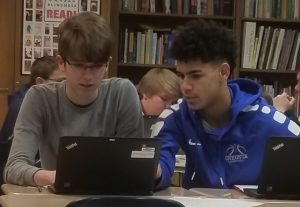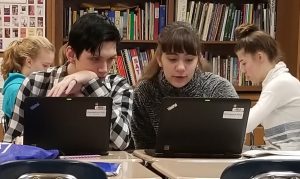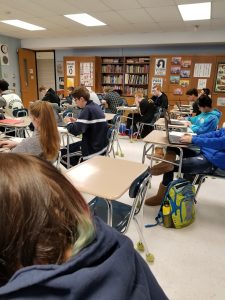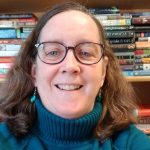This post was written by member Susan Murphy.
I have always dreaded midterm week because the entire process is time consuming, frequently painful, and often fruitless. This year, instead of taking a midterm exam, my students are involved in the YA Story Box project created by NCTE member Dr. Kevin Cordi of Ohio Northern University. The skills my students will gain from completing these stories (literary analysis, grammar, punctuation, vocabulary) are the same skills I would have assessed on a midterm exam.
Each participating school receives a box of almost sixty unfinished stories written by published YA authors, including Maggie Stiefvater, Cinda Williams Chima, and Margaret Peterson Haddix. Some of the story starters are as brief as one sentence, while some of the stories are as long as fifteen typed pages. Many of my students are “pumped,” including a few who have shown no interest in English class so far this year:
- “I was a little unsure about this project at first, but after reading and evaluating the stories, I became much more excited.”
- “I honestly love this project. I really need this story [by Mindy McGinnis] because I am writing a book myself and I’m currently stuck.”
- “This is creative and right up my alley. I can’t wait to see how my story ends [begun by Alan Gratz].”

There is an interesting mix of genres and topics in the Story Box. Plots involve everything from gnomes to time machines, stand-up comedy and slam poetry to Native American and Norse mythology, Oscar parties to algebra class. The students have learned a great deal about the author’s craft by completing these unfinished stories:
- “By doing this project, I’m being exposed to different styles of writing which helps me to be able to clearly read more types of books and to be able to write in these different ways.”
- “This is helping me become a better reader because I understand what it’s like creating characters and stories.”
- “I notice when I read [a story by Adrian Fogelin] that I recognize metaphors and similes faster and more easily.”
- “I always wanted to try stand-up comedy, and this [story by Patrick Flores-Scott] will give me that chance.”
My students are discovering why punctuation is necessary and how vocabulary can improve writing. At the end of the month, their stories will be placed in the Story Box that will travel to other high schools. At the end of the year, their stories will be read by the original author and, hopefully, a publisher. Because they want to look competent, the students are referring to grammar handouts and a thesaurus without being asked:
- “Writing is a weak spot for me, so I feel this story [by George Ella Lyon] will definitely help me to become a better writer.”
- “More focus is involved when I read these stories. I have to understand the story [by J. Patrick Lewis], but I also have to copy the author’s style, grammar, and punctuation. I really have to notice what’s on the page.”
- “Finishing this story [by Mindy McGinnis] is improving my grammar and dialogue skills. It’s opening a whole different part of my brain.”

The authors have encouraged the students to contact them, which humanizes the authors. Dozens of students have gone to the library to sign out books by “their” author:
- Aiden had a question about a story by Peadar Ó Guilín, and he realized that he could contact the author directly.
- Oana connected with her author on Facebook. “My author is a super nice person. She’s having a bad day and I feel so bad about it.”
Many have found a piece of themselves in a story, while others are excited to share their opinions and advice:
- “The character in this story [by Kristin Bartley Lenz] has a lot in common with me. I have experience with loss and leaving my home as well as a strong mourning for one of my siblings. This will help me express the moral that no matter what situation life brings you, never use that situation as an excuse to be anyone less than who you really are.”
- “I have moved many times and reading that someone else moved multiple times [story by Shelley Pearsall] gives me the chance to write about what I have encountered.”
- “I feel that as a group, high school voices aren’t heard all the time, but I do feel they matter. This story [by George Ella Lyon] will let my voice be heard.”
- “I can see myself in a few of these stories, mostly the sports stories and the outdoor/adventure stories [Carl Deuker], because those are the things that I love doing.”
- “Close your eyes and picture the most amazing thing—that’s my story [a fairy story by Sarah Hans].”

This project has brought out the best in most of my students. They are engaged, focused, excited to come to class, and eager to do homework. This project has awakened the creative spirit in my students and taught them a lot about literary analysis. It also has provided me an opportunity to learn more about them.
There are so many surprises hiding in the YA Story Box.
Note: Cover photo is of students Ursula Quadri, Angelica Goodhue and Mahala Johnson.
 Susan Murphy began her teaching career in 1980 and has been teaching at Oneonta High School in Oneonta, NY, since 1985. Currently, she is advisor to the school newspaper, The Echo.
Susan Murphy began her teaching career in 1980 and has been teaching at Oneonta High School in Oneonta, NY, since 1985. Currently, she is advisor to the school newspaper, The Echo.

